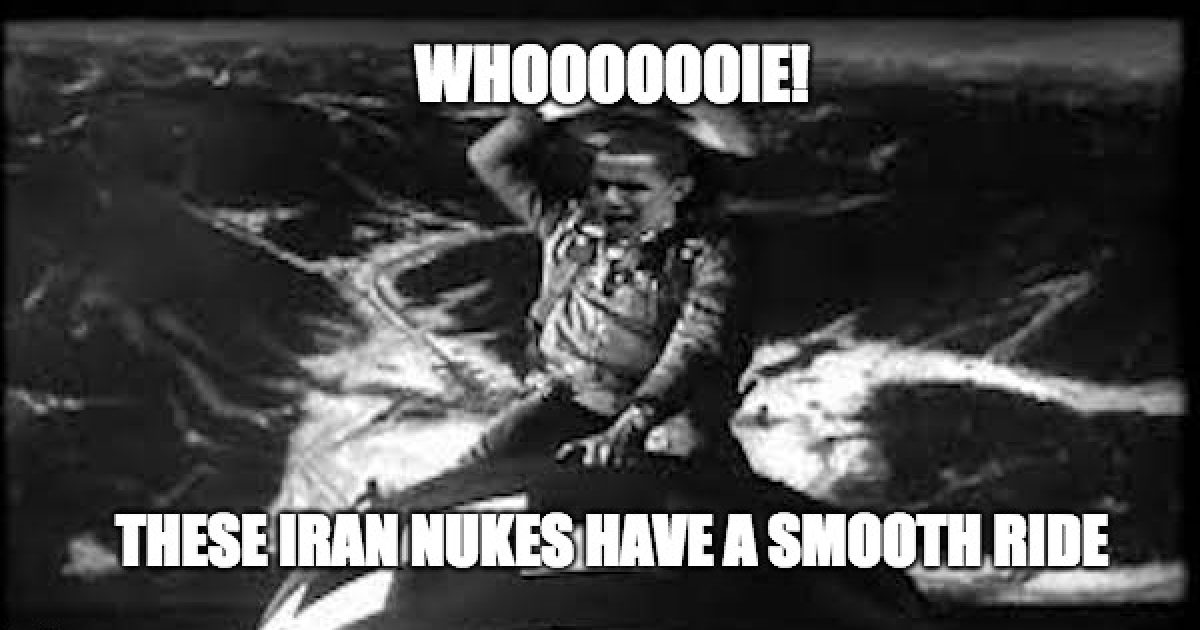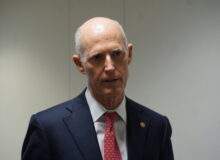Sometime before May 12th, President Trump will decide whether or not to pull the US out of the Iran nuclear deal, officially known as the Joint Comprehensive Plan of Action (JCPOA). While I have no knowledge what the president or his advisers are thinking, I do know that America was misled by former President Obama, former Secretary of State Kerry and their cronies when trying to sell the JCPOA to America. Additionally, parts of the deal were hidden from the public, and the Obama administration lied to America about other parts. Heck, the administration admitted it, in a New York Times Magazine piece Ben Rhodes explained how he led the administration’s efforts to misrepresent the truth in order “to sell” the JCPOA to the press.
The below are some of the elements of the deal that the Obama administration misled America about.
- The P5+1 deal gives Iran the capacity to enrich for bombs but NOT for power plants. The deal says that Iran can enrich fuel for peaceful purposes. However, under the agreement, Iran is allowed to keep 5,060 centrifuges, which according to former deputy director of the CIA Mike Morell is enough enrichment to produce bombs but not enough for a power program.
- The JCPOA lifted the ban on the Iranian ballistic missile program. Before the deal UN Security Council Resolution (UNSC) 1929, the council used mandatory language about ballistic missiles, it said, “It decides that Iran shall not undertake any activity related to ballistic missiles capable of delivering nuclear weapons.” The P5+1 resolution passed by the UNSC changes the language. The On page 119 of the UNSC approved P5+1 does not prohibit from carrying out ballistic missile work but asks them not to carry out ballistic missile development. The resolution merely says, quote, “Iran is called upon not to undertake such activity.” Some reports say that John Kerry begged Iran not to talk about the changes.
- The deal allows Iran to go nuclear after ten years. Do you remember when John Kerry insisted the Iran Nuclear deal was a “forever deal?” Kerry lied. Some of the provisions expire after year 10, and the rest of them after year 15. Based on the agreement, by the end of year 15, Iran could have in place a nuclear infrastructure that could produce the significant quantities of weapon-grade needed to create a few nuclear weapons within months.
- The promised sanction “snap-backs” don’t really exist. President Obama gave Europe, China, and Russia a written promise that the US will guarantee their companies who make deals with Iran, would not have to stop working with Iran should sanction need to be re-imposed should Iran get caught violating the P5+1 deal. Plus any snap-back needs to be passed by the UN Security Council where Russia gets a veto.
- According to the framework deal, Iran was supposed to reveal the details of their nuclear program. We were told that as part of the agreement Iran would have to “fess up” to the U.N. inspectors about their previous nuclear activity. The reason for this historical inquiry is not to find out whether or not Iran had a nuclear weapon’s program so they could be reprimanded for being bad children. The knowledge is needed to understand what the Iranian nuclear program was before the agreement so IAEA will know how, when, and where to inspect their program in the future. Iran told the IAEA that it never had a nuclear weapons program and that’s what the IAEA wrote in their report. If you believe Iran’s claim, I have a bridge connecting Brooklyn and Manhattan to sell you.
- The deal gives Tehran with the leverage to blackmail the West since the Iranians can threaten (and have threatened) to walk away from the JCPOA with a 35-day notice. Under Paragraph 36, Iran can claim that any of the P5+1 is “not meeting its commitments” under the agreement. That triggers a 35-day set of meetings. Once that clock runs, Iran can claim the issue “has not been resolved to [its] satisfaction” and that it “deems” that the issue “constitutes significant non-performance.” Iran can then “cease performing its commitments under this JCPOA in whole or in part.”
- Iran gets to “self-inspect” at the Parchin military site. Before the agreement, the IAEA sought access to Parchin which has long been suspected of being the location where Iran was developing it’s detonation systems for nuclear weapons. Iran even admitted to using Parchin to test exploding bridge wires, which are used as nuclear detonators, but they claimed the test explosions were not for weapons development.
The Obama administration had promised lawmakers that IAEA inspectors would be able to inspect Parchin and resolve all PMD (possible military dimension) issues before any final deal was inked. But that didn’t happen; instead, they allowed Iran to sign a secret side deal with the IAEA permitting the Iranians to self-inspect the facility rather than grant IAEA inspector robust access. An Iranian statement in Sept. 2015 confirmed that the Iranians collected their own samples, “Iranian experts took samples from specific locations in Parchin facilities this week without IAEA inspectors being present.” Why is self-inspecting bad? Well, one reason is, per a Catholic friend is that the nuns always told him that self-inspections will make Iranians eyesight go blurry and make them grow hair on their palms. But for the safety of America, an independent IAEA is necessary, unless one believes that Iran will turn itself in.
David Albright, president of the Institute for Science and International Security, explained at a panel hosted by the Hudson Institute that self-sampling even under surveillance is inadequate. Inspectors need to be on the ground to identify dusty nooks and corners where violators forgot to dust; the mutually agreed upon areas are by definition the ones that violators know have been sanitized:
“What you have is, is the situation where there’ll be videotaping of the potential locations where sampling would take place. Then the IAEA would direct the Iranians to take the samples. And that’s not the normal way to do things.
If I could give the example in Iran of Kalaya Electric, a secret centrifuge research and development facility that Iran denied was such a thing. The IAEA got access and it brought in a very top-level centrifuge expert with that access, who looked around. And when they did the sampling finally they didn’t find any trace of enriched uranium in the areas that had been heavily modified. But in another, a secondary building they found in a ventilation duct – which had not been modified – they found traces of enriched uranium…
You need the eyes and the brain to look where to sample.
I brought up an example of sampling in North Korea… they sampled in the Yongbyon reprocessing plant in the early 90s… you can see in the sampling they’re looking behind this box… Look for where it’s dusty. The idea is that it’s not been disturbed. In the case of Parchin, it would be looking for where the paint doesn’t look solid. And so, that’s very hard to do with a video camera. So I think the video camera opens up additional methods of deceiving the IAEA. And it’s not the normal way they’ve been doing it. And so I think that’s a problem…”
- Iran broke the terms of the heavy water provisions of the deal twice in 2016 but Obama let them “off the hook.”
- A secret side deal discovered by the Associated Press allows Iran to upgrade and modernize its centrifuges thus increasing its enriching capacity, all before the deal officially expires in 15 years. The projection is this will reduce the time for Iran to build a bomb to 6 months instead of the year time frame that was promised. but that six months was reduced even further by…Another secret side deal reported by the Institute for Science and International Security (and never given to Congress) reveals that Iran’s breakout time to a bomb is not a year as claimed by the Obama Administration but less than five months:
“As part of the concessions that allowed Iran to exceed uranium limits, the joint commission agreed to exempt unknown quantities of 3.5 percent LEU contained in liquid, solid and sludge wastes stored at Iranian nuclear facilities, according to the report. The agreement restricts Iran to stockpiling only 300 kg of 3.5 percent LEU [low-enriched uranium].”
“The commission approved a second exemption for an unknown quantity of near 20 percent LEU in ‘lab contaminant’ that was determined to be unrecoverable, the report said. The nuclear agreement requires Iran to fabricate all such LEU into research reactor fuel.”
“If the total amount of excess LEU Iran possesses is unknown, it is impossible to know how much weapons-grade uranium it could yield, experts said.”
- The JCPOA significantly reduces the reporting requirements for Iran’s nuclear program that existed before the deal.. That is according to IAEA Director General Yukiya Amano, the head of the international inspection group International Atomic Energy Agency. Iran threatened Mr. Amano with harm if he reveals anything about the side deals.
- There are two secret side deals to JCPOA that will not be shared with other nations, Congress, or with the U.S. public. Those side deals may be the ones revealed above…or maybe not..and perhaps there are more. In late 2016 the Daily Beast revealed there were private files outlining hidden agreements made as part of the Iran nuke never released by President Obama because he might find them embarrassing. Earlier Bloomberg View described other potentially embarrassing documents that the administration classified to save face, including intelligence assessments written to excuse the U.S. collapse on Iran disclosing past nuclear work.
The assessment began by imagining a world in which Iran will fully cooperate with the deal for the next 20 years, and then went from there. But there are dozens of other Iran nuke deal-related documents which are not even classified secret, but which the Obama administration has nonetheless refused to release. There are broad suspicions those documents contain embarrassing concessions to Iran: both additional U.S. obligations and exemptions for Iranian obligations. As a technical matter, it would be straightforward to release those documents. As a political matter, the Obama administration has consistently had trouble explaining why the public shouldn’t see them.
The Iran resistance group the National Council of Resistance of Iran (NCRI), which was the first to reveal certain elements of the Iran nuclear program to the world, claimed in April 2017 that the rogue regime has not stopped its nuclear weapons program despite the P5+1 nuclear deal negotiated by former secretary of state Kerry, and former President Obama.
Saudi Arabian Prince Salman warns that the Iranians aren’t using the money freed by the agreement to help the people
“President Obama believed that if he gave Iran opportunities to open up, it would change,” he said. “But with a regime based on this ideology, it will not open up soon. Sixty percent of the Iranian economy is controlled by the Revolutionary Guard. The economic benefits of the Iran nuclear deal are not going to the people.
“They took $150 billion after the deal — can you please name one housing project they built with this money? One park? One industrial zone? Can you name for me the highway that they built? I advise them — please show us something that you’re building a highway with $150 billion. For Saudi Arabia, there is a 0.1 percent chance that this deal would work to change the country. For President Obama, it was 50 percent. But even if there’s a 50 percent chance that it would work, we can’t risk it. The other 50 percent is war. We have to go to a scenario where there is no war.”
The Prince is correct when he says there is no change in Iranian behavior, in December 2017 the NCRI detailed how Iran is using those ill-gotten funds to support terrorism throughout the world.
Keep in mind that the only reason President Trump can kill the deal is President Obama’s Just as he did with DACA and elements of Obamacare, the former POTUS knew he didn’t have the votes needed in the Senate to approve a treaty, and the deal didn’t have the support of the American people so he couldn’t put pressure on the Senate to approve the treaty. Like most progressive, President Obama believed he knew better than the American people, so he did not submit the deal in a constitutional manner as a treaty…that would have tied President Trump’s hands. Instead, Obama skirted the constitution and treated it as an Executive Agreement which like executive orders doesn’t even tie President Trump’s shoes.
When he was Washington’s Secretary of State, Thomas Jefferson wrote:
It is desirable, in many instances, to exchange mutual advantages by Legislative Acts rather than by treaty: because the former, though understood to be in consideration of each other, and therefore greatly respected, yet when they become too inconvenient, can be dropped at the will of either party: whereas stipulations by treaty are forever irrevocable but by joint consent.
Executive agreements like other executive actions can be tossed in the trash at any time.
As it turned out, the Senate never even voted on the deal because Senators such as NY’s Kirsten Gillibrand ignored their voters and filibustered the motion to vote. After all the Democrats didn’t want their Senate caucus to have to go on the record supporting the deal and ignoring the constitution.
President Trump said his final decision about the JCPOA would be based on achieving three improvements to the deal. First, eliminate the provisions under which key nuclear restrictions expire over time. Second, stop Tehran’s nuclear-capable long-range missile program. Finally, allow for the inspection of military sites where the regime conducted clandestine nuclear activities in the past and may be doing so now.
While there have been negotiations going on between the State Department and the European signatories it is not for changing the present JCPOA but to create an agreement that will go along with the deal and meet President Trump’s objections. However, even if the European countries agree, and even if they get the Russians to bite let’s be real, Iran didn’t agree with those provisions when their economy was being crippled by sanctions before the JCPOA, there is no way Iran will agree now–especially when Britain, France, German and Russia will not reimpose sanctions and the rogue Iranian regime will be able to continue its march toward nuclear weapons, unabated.






